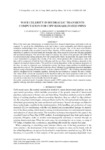Mostrar o rexistro simple do ítem
Wave Celerity in Hydraulic Transients Computation for CIPP-Rehabilitated Pipes
| dc.contributor.author | Evangelista, F. | |
| dc.contributor.author | Hernández, Santiago | |
| dc.contributor.author | Mambretti, Stefano | |
| dc.contributor.author | Parola, D. | |
| dc.date.accessioned | 2021-01-15T20:17:18Z | |
| dc.date.available | 2021-01-15T20:17:18Z | |
| dc.date.issued | 2020 | |
| dc.identifier.citation | Evangelista, F., Hernandez, S., Mambretti, S., & Parola, D. (2020). Wave celerity in hydraulic transients computation for CIPP-rehabilitated pipes. International Journal of Computational Methods and Experimental Measurements, 8(4), 326-340. DOI: 10.2495/CMEM-V8-N4-326-340 | es_ES |
| dc.identifier.uri | http://hdl.handle.net/2183/27162 | |
| dc.description.abstract | [Abstract] Most of the water pipe infrastructure is outdated; therefore, frequent maintenance and repair works are required. To speed up the rehabilitation work and to have a more sustainable and efficient approach, trenchless methodologies have been developed in the last decades. One of the most cost-effective trenchless methods is the so-called Cured in Place Pipeline (CIPP) method, in which a resin-impregnated liner is pulled or inverted inside the host pipe and, when cured, it restores the old pipe structural and mechanical integrity. The aim of this study is to analyse the effects of the presence of a CIPP liner in a deteriorated pipe during unsteady flow for compressible fluids. In particular, the paper deals with a new formulation to compute the celerity of the wave which produces the overpressures, when the pipe wall is composed of both the host (old) pipe and the new liner, whose thickness depends on the required mechanical characteristics. The problem is strictly dependent on the mechanical properties of the liner. In order to obtain the new formula for celerity, the linear elastic problem for multi-layered pipes has been solved. The theoretical results have been validated by performing numerical simulation analysis using a Boundary Element model, with the software BEASY™. The resulting circumferential strain is integrated in the continuity equation, deriving the new formula to compute the wave celerity. The values of the celerity are dependent on the thickness and on the elastic properties of the liner. The behaviour of several combinations of thickness of the liner and Young’s modulus values has been studied and the results have been critically shown in the paper. | es_ES |
| dc.language.iso | eng | es_ES |
| dc.publisher | WIT Press | es_ES |
| dc.relation.uri | https://doi.org/10.2495/CMEM-V8-N4-326-340 | es_ES |
| dc.rights | Copyright: WIT Press | es_ES |
| dc.subject | Analytical model | es_ES |
| dc.subject | Boundary element model | es_ES |
| dc.subject | CIPP | es_ES |
| dc.subject | Confined liner | es_ES |
| dc.subject | Elastic transient motion | es_ES |
| dc.subject | Pipeline relining | es_ES |
| dc.subject | Trenchless methods | es_ES |
| dc.subject | Water hammer | es_ES |
| dc.subject | Wave celerity | es_ES |
| dc.title | Wave Celerity in Hydraulic Transients Computation for CIPP-Rehabilitated Pipes | es_ES |
| dc.type | journal article | es_ES |
| dc.rights.accessRights | open access | es_ES |
| UDC.journalTitle | International Journal of Computational Methods and Experimental Measurements | es_ES |
| UDC.volume | 8 | es_ES |
| UDC.issue | 4 | es_ES |
| UDC.startPage | 326 | es_ES |
| UDC.endPage | 340 | es_ES |
| dc.identifier.doi | 10.2495/CMEM-V8-N4-326-340 | |
| UDC.coleccion | Investigación | es_ES |
| UDC.departamento | Construcións e Estruturas Arquitectónicas, Civís e Aeronáuticas | es_ES |
| UDC.grupoInv | Mecánica de Estruturas (ME) | es_ES |
| UDC.institutoCentro | CITEEC - Centro de Innovación Tecnolóxica en Edificación e Enxeñaría Civil | es_ES |
Ficheiros no ítem
Este ítem aparece na(s) seguinte(s) colección(s)
-
Investigación (ETSECCP) [826]






